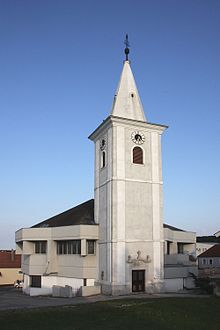Parish church of Klingenbach
The Roman Catholic parish church of Klingenbach is located in the mixed-language community of Klingenbach in the Eisenstadt-Umgebung district in Burgenland . The parish church of St. James the Elder belongs to the dean's office in Rust in the Diocese of Eisenstadt . The church is a listed building .
history
The first documentary mention was in 1276, when the former town judge of Ödenburg named Pero donated the community of Klingenbach including the Jakobskirche there to the Cistercians from the Marienberg monastery. There is a so-called Klingenbacher Missal, a missal that contains historical notes. After the Turkish wars and extensive destruction, Croatians settled the place. This is where the oldest documents of Croatian literature in Burgenland were created .
In 1804 the chapel-like church was demolished and a new, larger church was built with the consecration on November 30, 1804, although the completion was not completed until spring 1805. The bell tower of the previous church was left. Pope Pius VII granted St. Jakobskirch a complete indulgence in 1805, which is still given today on White Sunday and the Patronage Festival. In 1880 the place counted 948 Catholics and 11 Jews. Due to a lack of space, the church was extended by a side chapel.
With the establishment of Burgenland in 1921, the parish came to the former dean's office Kleinfrauenheid of the then Apostolic Administration Burgenland, from 1960 diocese Eisenstadt . On January 30, 1927, politics cast a shadow over the region: Matthias Csmarits, an unskilled worker, was shot in a brawl between front-line soldiers and Schutzbündlers in Schattendorf , whereupon 6,000 unemployed people from Vienna took part in the funeral in Klingenbach. The church was badly damaged on April 1, 1945 when Klingenbach was liberated by the Soviet Army in World War II . In 1948 the church tower was repaired and fitted with new bells. In 1954 the roof and the church were renovated. With a view to the town's anniversary year 1976, Pastor Stefan Geosits founded a church building association for a new building in 1972. Due to resistance, the building permit was initially rejected, but approval was given a month later. After Whit Monday 1975 the old church was demolished. The church tower was left. The church was built according to plans by the architect Josef Patzelt by the local builder Matthias Wild and consecrated on August 22, 1976 by Bishop Stephan László .
architecture
The third church building now stands next to the church tower. The square tower shows its three storeys through cornices, has a round gable roofing with pine cones at the top and an octagonal stone helmet. The bell chamber with arched sound windows is framed with Tuscan pilasters. The church tower cross shows the year 1740. Above the rectangular framed door is an inscription plaque with the chronogram <1740 SIT / PAX HVIC DOMVI / POPVLOQVE INTRANTI / SALVS>. The cemetery was around the Jakobskirche until 1772. In the course of the demolition of the church in 1975 a tombstone was found <ALHIER LIGT BRAWN THE SEL MATHIAS WISCHNITZ HIS AGE 94 YEARS DIFFERENT 24 MEY ANNO 1717>, which was walled into the tower.
The church and the seating arrangement has the shape of an octagon and enables the casual distribution of those celebrating in the same way as a field mass. The concentric main room expresses the meal community. The cramped construction site with the preservation of the tower led to the placement of the sacristy under the singing gallery. A prayer room for gathering and meditating was also created. The confessional room was set up on the tower ground floor.
Furnishing
There is a statue of the Virgin Mary with baby Jesus from 1713. A colored window of St. James from 1954 was preserved and transferred to the church. The organ was built around 1900 by the organ builder Franz Capek from Krems and repaired and rebuilt in 1976 by the organ builder Herbert Huber in Eisenstadt.
literature
- The art monuments of Austria. Dehio Burgenland 1976 . Klingenbach, Catholic parish church hl. James d. Ä., P. 152.
- Stefan Geosits: 700 years of St. Jacob's Church and Klingenbach Parish. 700 ljet crikva svetoga jakova u Klimpuhu. Tusch Druck, Vienna 1976, 112 pages, pages 81 to 96 in Croatian.
- Stefan Geosits (ed.) With Nikolaus Bencsics, among others: The Burgenland Croats through the ages. Edition Tusch, Vienna 1986, ISBN 3-85063-160-5 .
Web links
Coordinates: 47 ° 45 ′ 14.3 ″ N , 16 ° 32 ′ 21 ″ E

